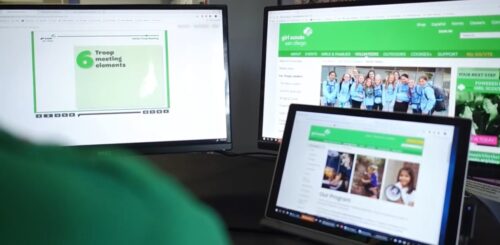Training at Non-profits: How Girl Scouts San Diego Empowers its Volunteers
When Girl Scouts San Diego (GSSD), was looking for a way to train its troop leaders, the organization faced a challenge: Girl Scout troop leaders are volunteers.
Non-profit organizations face a unique set of training challenges, one of which is that many of their learners are volunteers. Unlike GSSD, which does require some training, not all organizations can mandate training for volunteers and non-employees. Also, non-profit organizations that rely on remote groups of volunteers with diverse backgrounds may find it hard to reach their volunteer workforce. Volunteers may be spread over a large geographical area, they may not all have time to attend in-person workshops, and some of them might be unfamiliar with online learning.
GSSD, for example, relies on 14,000 volunteers to support the 23,000 scouts in its troops. The troop leaders come from a variety of backgrounds — some are highly educated, some work in corporate America, some don’t have a lot of formal education, and some have never worked in an office setting.
While online learning makes training such a far-flung group of volunteers possible, it’s still a challenge to design an inclusive training program that works for such a diverse group of learners. You need to be sure both your content and your learning platform itself is accessible and inclusive for all learners.
Watch this video of how Girl Scouts San Diego uses Litmos Training to align its volunteers with its powerful mission.
Reach volunteers where they are
Volunteers are, by nature, busy people. How busy? According to the Bureau of Labor Statistics (BLS) most volunteers have jobs — 27 percent of employed people volunteer, although part-timers are more likely to volunteer than full timers. They also tend to have families; married people and parents with children under 18 volunteer at a higher rate than their peers. This is certainly the case with GSSD, where troop leaders are often the parents of Girl Scouts.
When your volunteers are not working for your organization, they are likely at work, driving family members to appointments and activities, or involved with other obligations. You have to be able to reach your volunteers where they are, when they have time. That means providing training while they are on lunch break at work, hanging out in the car during a child’s soccer practice, or waiting around at another volunteer gig (after all, 30% of volunteers give time to more than one organization). It’s important to provide training they can access on their phones or any other devices.
It is also important to note that volunteers come from a wide range of income levels and educational backgrounds. Some may be able to access learning on their phones, others may share a desktop with family members. You need to be able to reach them all, with learning that can be accessed from every device.
Soft skill training for volunteers
You don’t hire volunteers; they come to you and offer their skills to your organization because they want to help.
However, just as volunteers bring their skillsets with them when they donate their time to your organization, they may also bring their skill deficits, and some of those deficits may involve soft skills.
Soft skills – like empathy, time management, and communication — are the skills that make a person pleasant to work with, and they can be a major stumbling block for nonprofit organizations that depend on volunteer workers. After all, if a volunteer comes to you with impressive hard skills (if they’re a lawyer willing to do pro bono work, for example) you may not turn them away for being a poor communicator, but the volunteer’s poor communication skills will still reflect poorly on the organization. It’s the same with a carpenter with time management problems, or a troop leader who lacks empathy.
You may not be able to fire a volunteer, but you can train them, and rather than developing soft skills content from scratch, you may opt to choose a learning platform that offers off-the-shelf soft skill content.
 Training a diverse group of volunteers
Training a diverse group of volunteers
Volunteers like the GSSD troop leaders give their time for a variety of reasons; some want to give back to the community; some have a child involved in scouting, and some may have fond memories being a scout themselves.
They also come from a wide range of backgrounds; some troop leaders might work part time or be stay-at-home parents. Others may work in an office setting. This troop leader diversity is typically a strength for GSSD, but in this case, it creates an e-learning divide; the volunteers who work in a corporate setting are already familiar with learning management systems (LMS) but many of those who have not worked in an office setting may not be familiar with LMS tools at all.
A complex learning platform can turn off someone who isn’t used to taking courses or modules online. If they have to spend too much time figuring out an LMS, they may become frustrated and tune out, put off their training, or just not take their courses at all.
This was a problem for GSSD because their volunteers work with children, and need to be trained regularly in order to lead their troops confidently and well. Therefore, their learning management system had to be easy to use and intuitive, for everyone.
How Girl Scouts San Diego trains its volunteers
GSSD resolved their training challenges by choosing Litmos LMS for its ease of use, so that all of its troop leaders can log in wherever they are and take courses easily.
“We really looked for a Learning Management System that would be easy to access, super flexible, and inclusive of all of our kinds of learners, and we landed with Litmos. One of the cool things that’s happened as a result of using Litmos and building more content is that we have more people learning, period.”
— Sandy Sultz, Adult Learning Manager for GSSD
Twice the number of volunteers are taking training than in previous years and 99 percent of the learners who’ve completed the GSSD’s New Leader Course say it was “helpful” or “very helpful.”
“That’s a huge figure for us,” said Sultz.
What’s more, learners say they feel more confident and better equipped for troop leadership as they move forward with their girls.






